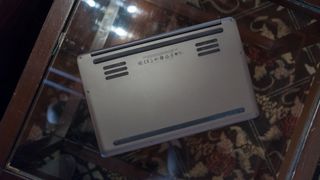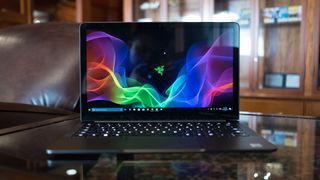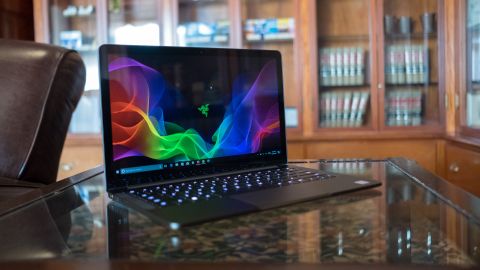Why you can trust TechRadar
Here’s how the Razer Blade Stealth (late 2017) performed in our suite of benchmark tests:
3DMark: Sky Diver: 4,174; Fire Strike: 1,030; Time Spy: 392
Cinebench CPU: 530 points; Graphics: 47 fps
GeekBench: 4,588 (single-core); 14,621 (multi-core)
PCMark 8 (Home Test): 3,021 points
PCMark 8 Battery Life: 3 hours and 25 minutes
Battery Life (TechRadar movie test): 5 hours and 9 minutes
Let’s see how that compares to the mid-2017 model:
3DMark: Sky Diver: 4,030; Fire Strike: 944; Time Spy: 372
Cinebench CPU: 339 points; Graphics: 43 fps
GeekBench: 4,221 (single-core); 8,280 (multi-core)
PCMark 8 (Home Test): 2,644 points
PCMark 8 Battery Life: 3 hours and 37 minutes
Battery Life (TechRadar movie test): 5 hours and 25 minutes
Quad-core Kaby Lake Refresh processors have helped the Razer Blade Stealth make a huge leap in performance. While it’s a given that more cores usually lead to better performance, these benchmark numbers are impressive nonetheless.
For starters, the 8th-generation Intel processors deliver a more than 75% increase in multi-core performance compared to 7th-gen Kaby Lake. This in turn leads to correspondingly higher scores in Cinebench and PCMark 8.
What's most surprising are the graphical enhancements that Intel UHD Graphics brings, going by the 4% to 9% improvement in 3DMark scores at least.
You can fire up Overwatch on the Razer Blade Stealth for a smoother gaming experience with higher frames per second, but you’ll still be relegated to playing the game at awfully low settings. And that pretty much goes for most games you try to play on this Ultrabook.
Compared to other brand-new Kaby Lake Refresh CPU-powered Ultrabooks, the Blade Stealth keeps in step with the Dell XPS 13. Of course, it blows away the MacBook Pro due to that machine having a 7th generation Intel Kaby Lake chip inside.
That said, the Lenovo Yoga 920 leads the pack by a slight margin with the best overall benchmark scores.

Battery life
While we’re seeing performance improve year-over-year, the Blade Stealth’s battery life has also taken a hit with every iteration. The latest version ran our movie playback battery test for five hours and 9 minutes, which was shorter than the five hours and 25 minutes of the previous Kaby Lake-powered edition – and that was already down from the five hours and 44 minutes result we saw from the 12.5-inch 2016 model.
The culprits behind these battery life decreases are the larger, sharper screen and the new quad-core processor. Going from the 12.5-inch model we tested in 2016 to the 13-inch refresh, the display is not only physically larger, but the screen resolution increased from 2560 x 1440 to 3200 x 1800. Likewise, the two additional cores on the Kaby Lake Refresh processor can’t improve performance without also consuming more power.
The Blade Stealth also lags behind its peers for longevity. The 13-inch MacBook Pro with Touch Bar was able to run the same movie test for 6 hours and 37 minutes. Meanwhile, the Dell XPS 13 lasted for an remarkable 10 hours and 29 minutes. Of course, both these Ultrabooks feature lower-resolution screens. Had the Blade Stealth come with a Full HD display, it would likely last for seven or more hours.
Five hours of battery life – which we could easily stretch to six hours – isn’t terrible, but it also isn’t great. You’ll have to completely turn off the keyboard backlight and lower your screen brightness to get through a cross-country flight. We also wouldn’t feel comfortable bringing this Ultrabook to work without its charger.

Inputs and outputs
As with previous generations, the Blade Stealth comes with potently powerful speakers and a larger, more tactile keyboard than the MacBook Pro. What has changed this year is that Razer upgraded its Ultrabook with a Windows Precision Touchpad.
We didn’t have many complaints with the trackpads on previous models, but the direct-from-Microsoft drivers offer even better tracking and multi-touch gesture recognition. So, we’ll take the improvement on the laptop’s pointing device even if we felt it wasn’t absolutely necessary.
We liked
The Razer Blade Stealth’s smaller, 12.5-inch display and thick bezels always irked us before but, the inclusion of a full-on 13-inch screen fully levels the playing field against other Ultrabooks. The IGZO display also looks better than ever, with an even wider color gamut and higher maximum brightness. But what’s truly impressive is that this Ultrabook didn’t need to get any bigger to accommodate the larger screen.
In terms of performance, this is the most powerful Ultrabook Razer has released, keeping perfectly in step with its rivals. At the same time it’s also far more affordable, which should give you plenty of reason to consider it above its contemporaries.
We disliked
The steady decrease in battery life we’ve seen with each successive Blade Stealth is a big disappointment. While we would have considered five hours of battery life as being pretty decent earlier in the year, we’re now seeing other Ultrabooks last for 10 hours or more, completely overshadowing this one.
This is still an absolutely portable laptop, but you’ll want to mind that battery meter more carefully than if you went with some other options on the market.

Final verdict
With the 13-inch screen and the latest 8th-generation Intel processors, the Razer Blade Stealth has matured into the Ultrabook we always wanted. The larger display and the half-sized bezels make this laptop look all the more attractive, while the brighter screen and Windows Precision Touchpad addressed our other, smaller, qualms from last year.
Aside from the middling battery life, the Razer Blade Stealth is completely on a par with, if not even better than, other similarly-specced Ultrabooks. For a reasonable price, it comes just as well-equipped, and performs equally, to the most premium offerings from Dell, Lenovo or HP.
Kevin Lee was a former computing reporter at TechRadar. Kevin is now the SEO Updates Editor at IGN based in New York. He handles all of the best of tech buying guides while also dipping his hand in the entertainment and games evergreen content. Kevin has over eight years of experience in the tech and games publications with previous bylines at Polygon, PC World, and more. Outside of work, Kevin is major movie buff of cult and bad films. He also regularly plays flight & space sim and racing games. IRL he's a fan of archery, axe throwing, and board games.

The obscure little PC that wanted to be a big NAS — super compact Maiyunda M1 doesn't cost that much, offers up to 40TB SSD storage, runs Windows and has 4 Gigabit Ethernet ports

Image site Abload going offline reminds me of how much online content we've permanently lost

Gemini's next evolution could let you use the AI while you browse the internet

